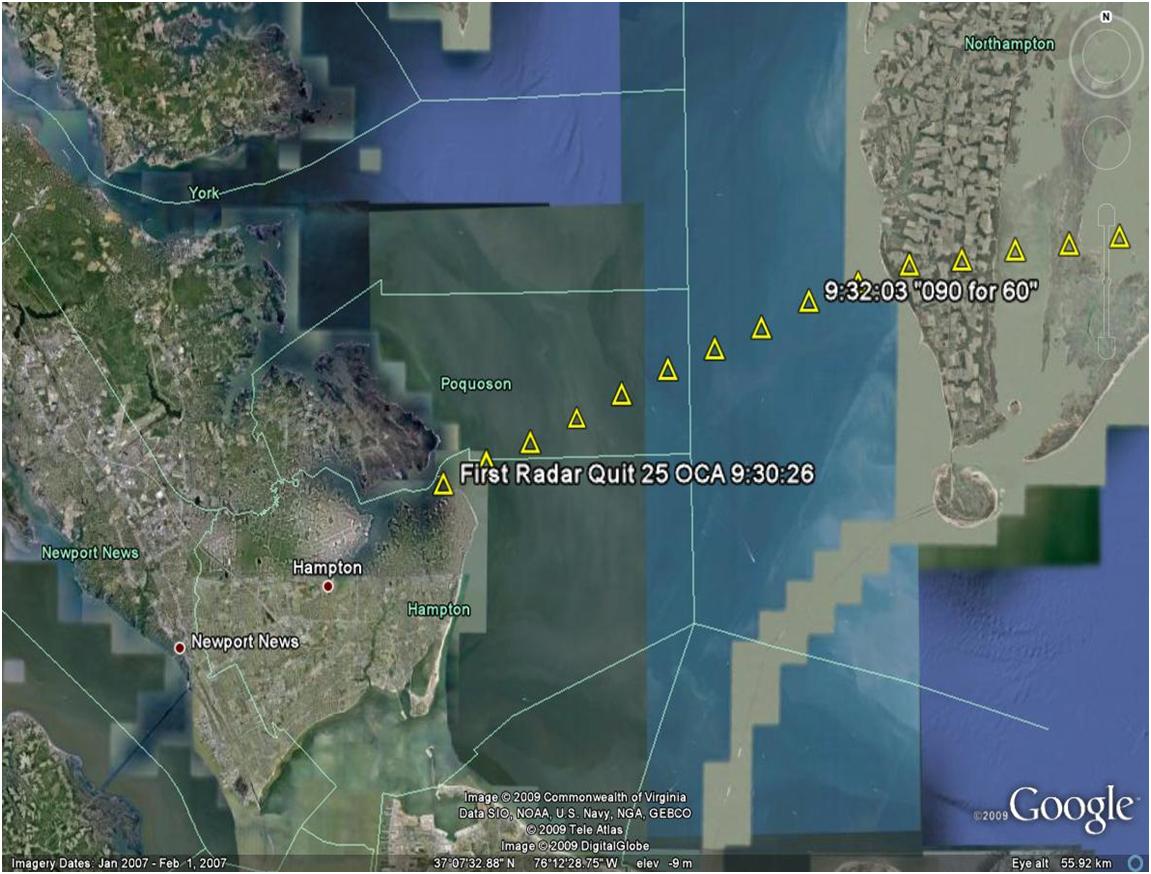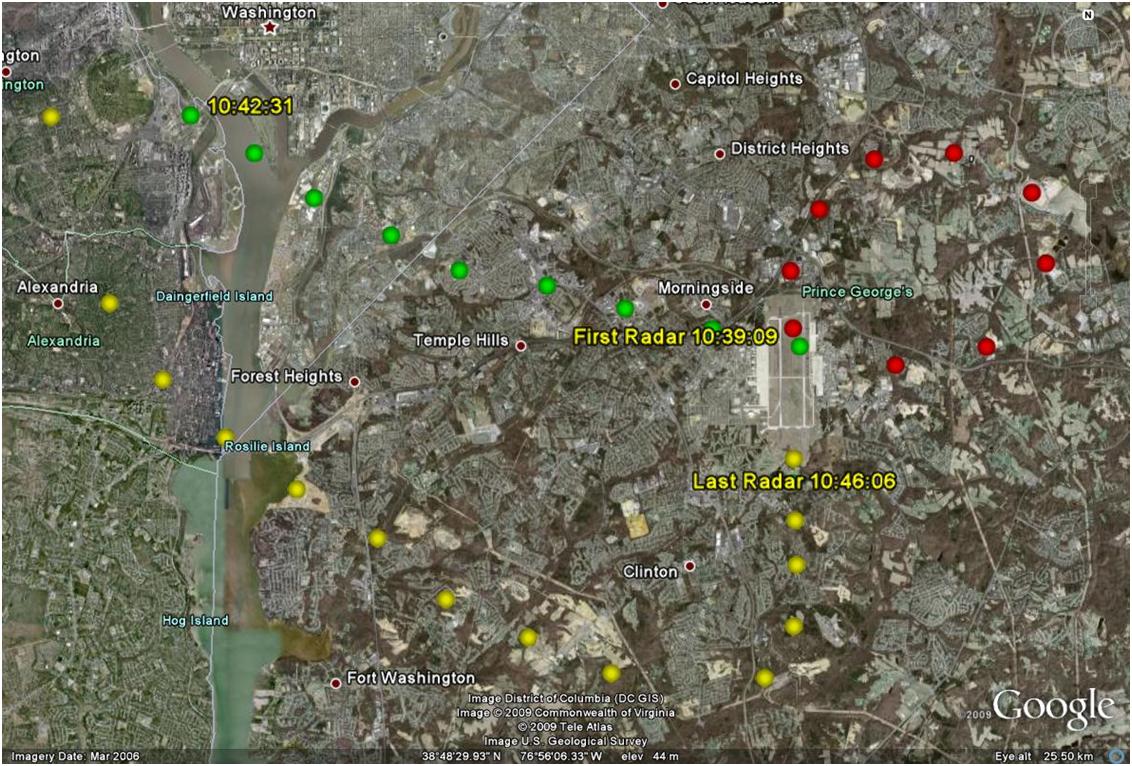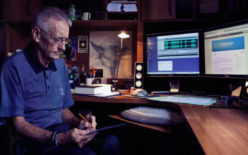The Pentagon was struck at 9:38; Andrews Air Force Base is a short flight distance away yet its fighter assets were never a factor on 9-11. In the Mystery Plane article I discussed the sequence of planes that took off that morning from Andrews before and immediately after the Pentagon was struck; except the fighters which I said was a separate story. Here is that story.
The Andrews fighters were coming out of a previous day stand down because of a recent return from extended training in Nevada. Nevertheless, they had 5 planes and a like number of pilots scheduled for training. Three of those planes, the Bully flight of three, departed for training over eastern North Carolina skies at 8:36. The Andrews flight strip states, in part: “Bully 1…3/F16/R…ADW DCNG…1236.” The flight was led by, then, Major Billy Hutchison. Ultimately, four additional planes and pilots became available, but it was the Bully flight, specifically Hutchison, that would later be the first Andrews responder.
Before continuing further with the Andrews story we need to go back and revisit the Langley fighters for a moment. In the second Langley article I discussed the scramble procedures extant at the time. Those procedures specified that regardless of flight plan the Langley fighters would proceed on runway heading to an altitude of 4000 feet. That segment of the flight is clearly visible on the ground trace of the Langley fighters as determined from 84th RADES radar data.

And it is at that point, just short of the Delmarva Peninsula, that the Norfolk Tower controller and the Quit 25 pilot decided that the flight plan, 090 for 60 prevails over the scramble order and the Quit flight turned slightly right to its flight plan heading. But what does this mean in terms of the NORAD response to events of the day?
Had Quit 25 turned north at that point his flying time to the NCA was still on the order of 12 minutes or so at maximum subsonic, a rate of progress determined over time to be the most effective air defense solution to account for safety, to provide time on target, and to allow an approaching fighter a reasonable chance to spot his target. The Quit flight was not going to have a chance to intercept AA 77 even if the scramble had proceeded as NEADS intended. That meant that NORAD had no chance to effectively engage three of the four hijacked aircraft, AA11, UA 175 and AA 77. That leaves just UA 93 as the only hijacked airplane that either Langley or Andrews would be able to engage. It also mitigates the two askew segments of the Quit flight path to the NCA; they still arrived in time to guard against an approaching UA93; something the Andrews fighters did not do.
The misinformation that AA 11 was still airborne and headed south was the catalyst that got the Langley fighters airborne as soon as they were. It is only because of a proactive error by the Boston air traffic controller, Colin Scoggins, that the nation’s air defenders had any real chance to defend against UA 93; but the expeditionary force fighters at Andrews did not receive that same warning; their warning would come later as we are about to see.
Even though controllers at the scope level at Dulles TRACON had seen a “no tag” soon after 9:25 that observation did not become actionable until Danielle O’Brien saw the fast mover, checked her observation with her fiancé’ sitting at an adjacent screen, and sounded the alarm at 9:33 to National TRACON. Soon thereafter her supervisor notified the Secret Service and quickly the Service and National TRACON established an open line. The Service also picked up the phone and called the late General Wherley at Andrews.
General Wherley’s notes at the time, as reflected in Commission Records (Team 8 Box 8. History Commons is aware of newly released documents), show a time of 0930L (9:30 EDT). The time was actually closer to 9:35. By that time the Secret Service was also following the fast moving unknown, now tagged with an “S,” by National TRACON, visible to the Service. There is a misconception that because the Secret Service had a working relationship with National TRACON that the Service could see any FAA radar feeds from anywhere in the country. That is not true, the only thing the Service could see was what National TRACON was seeing, nothing more.
So, the Andrews alert came at 9:35. It would take them the better part of two hours to get armed fighters in the air with the authority to act. The Langley fighters, scrambled at 9:24 established a CAP over the nation’s capital 36 minutes later, albeit without authority, despite two askew flight segments. How can there be such a difference?
The difference is in the roles and missions of the day, a specific determination by the Department of Defense in order to most effectively use its resources. Just as the three services and the Marines have specific roles and missions, so do their major components and subcomponents. We can leave a more detailed discussion of that for another day, suffice it to say here that the air defense mission and the role of the Langley (and Otis) fighters is distinctly different from the expeditionary force mission and the role of its fighters, such as the Andrews contingent. Only the CONUS air defenders had the tactics, techniques and procedures in place to respond rapidly, and there were just 14 fighters with that mission at seven locations; just two of those locations and four of the fighters were immediately available to NEADS.
Andrews went to work immediately to upload its aircraft and respond, but that took time, time that they did not have. They also recalled the Bully flight, first Bully 2 and then Bully 1 and 3. Even though the Langley fighters had effectively CAPPed the nation’s capital by 10:00 that was not understood or even known within the NCA, including the White House. So when things turned serious with the approach of a now notional UA93, as seen on traffic situation displays at multiple locations, the pressure on Andrews intensified; they had to do something. None of this had anything to do with AA 77 despite accounts to the contrary.
The Andrews flight strips show that Bully 2, who came back alone and well ahead of Bully 1 and 3, landed at 10:14 out of fuel. Bully 1, a flight of two F-16s landed at 10:35, low on gas; however, Bully 1 had sufficient fuel to take off again in response to an unknown coming down the river. By then, the notional UA 93 had “landed” at National at 10:28. There was nothing to intercept. Here is a ground trace of the flight of Bully 1 based on data from 84th RADES.

Major Hutchison was airborne by 10:39 and flew three specific routes. First, he circled to the east back directly over Andrews climbing to an altitude of 3600 feet, shown in red. He then flew directly to the Pentagon, shown in green, and overflew the building at 600 feet shortly after 10:42, exactly as described by Creed and Newman in Firefight to Save the Pentagon. He then turned south, shown in yellow, and climbed back to 3600 feet before landing back at Andrews a short seven minutes after taking off. He was not given “weapons free” authority by General Wherley. The Andrews flight strips show him cleared for takeoff at 10:36 and back on the ground at 10:47, an eleven minute period. Flight strips are not definitive; the radar shows that, at best, Hutchison was in the air for just over seven minutes.
His presence was no longer needed. A pair of Andrews fighters, guns only, and with only verbal (text modified on July 19 based on Commission work files). “weapons free” authority had taken to the air. A handwritten flight strip shows “CAP 1, 2 F-16, airborne at 10:51. (Here I give the benefit of the doubt, the handwriting is not clear and it could be 10:57.) Finally, at 11:12, Andrews was able to launch the Wild flight of two F-16, fully armed, and General Wherley did give them “weapons free” authority. The Wild pilots were the other two scheduled for training that day.
Given that all hijacked aircraft had been accounted for, the only issue left by the time the Wild flight got airborne was command and control of the skies over the nation’s capital. That became a bit contentious between the Langley and Andrews fighters. Lynn Spencer in Touching History has a good account of the ‘battle’ for command and control. Spencer, by the way, is the only person who has told an unsung story in the skies that day, the efforts of civilian pilots to help air traffic control. It is a story well told.
Air defense forces and expeditionary forces compared. It took the expeditionary forces, Andrews, 97 minutes (9:35 to 11:12) to retool and reconfigure and get fully armed planes with shootdown authority into the air over the National Capital Region. It took the air defenders, NEADS/Langley, 51 minutes (9:09 to 10:00; recall that the Langley fighters were placed on battle stations at 9:09) to get fully armed planes over the National Capital Region, but with the authority to only identify by ‘type’ and by ‘tail.’ In sum, given the attack and response as it unfolded that day, neither force could have done anything to prevent the WTC and Pentagon tragedies. Only the air defense force was in position to do anything about United 93 had its passengers not taken matters into their own hands.
